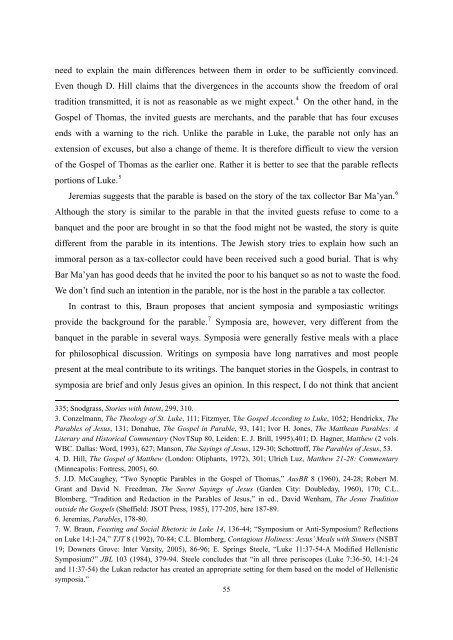the role of the lukan parables in terms of the purpose of luke's gospel
the role of the lukan parables in terms of the purpose of luke's gospel
the role of the lukan parables in terms of the purpose of luke's gospel
Create successful ePaper yourself
Turn your PDF publications into a flip-book with our unique Google optimized e-Paper software.
need to expla<strong>in</strong> <strong>the</strong> ma<strong>in</strong> differences between <strong>the</strong>m <strong>in</strong> order to be sufficiently conv<strong>in</strong>ced.<br />
Even though D. Hill claims that <strong>the</strong> divergences <strong>in</strong> <strong>the</strong> accounts show <strong>the</strong> freedom <strong>of</strong> oral<br />
tradition transmitted, it is not as reasonable as we might expect. 4 On <strong>the</strong> o<strong>the</strong>r hand, <strong>in</strong> <strong>the</strong><br />
Gospel <strong>of</strong> Thomas, <strong>the</strong> <strong>in</strong>vited guests are merchants, and <strong>the</strong> parable that has four excuses<br />
ends with a warn<strong>in</strong>g to <strong>the</strong> rich. Unlike <strong>the</strong> parable <strong>in</strong> Luke, <strong>the</strong> parable not only has an<br />
extension <strong>of</strong> excuses, but also a change <strong>of</strong> <strong>the</strong>me. It is <strong>the</strong>refore difficult to view <strong>the</strong> version<br />
<strong>of</strong> <strong>the</strong> Gospel <strong>of</strong> Thomas as <strong>the</strong> earlier one. Ra<strong>the</strong>r it is better to see that <strong>the</strong> parable reflects<br />
portions <strong>of</strong> Luke. 5<br />
6<br />
Jeremias suggests that <strong>the</strong> parable is based on <strong>the</strong> story <strong>of</strong> <strong>the</strong> tax collector Bar Ma’yan.<br />
Although <strong>the</strong> story is similar to <strong>the</strong> parable <strong>in</strong> that <strong>the</strong> <strong>in</strong>vited guests refuse to come to a<br />
banquet and <strong>the</strong> poor are brought <strong>in</strong> so that <strong>the</strong> food might not be wasted, <strong>the</strong> story is quite<br />
different from <strong>the</strong> parable <strong>in</strong> its <strong>in</strong>tentions. The Jewish story tries to expla<strong>in</strong> how such an<br />
immoral person as a tax-collector could have been received such a good burial. That is why<br />
Bar Ma’yan has good deeds that he <strong>in</strong>vited <strong>the</strong> poor to his banquet so as not to waste <strong>the</strong> food.<br />
We don’t f<strong>in</strong>d such an <strong>in</strong>tention <strong>in</strong> <strong>the</strong> parable, nor is <strong>the</strong> host <strong>in</strong> <strong>the</strong> parable a tax collector.<br />
In contrast to this, Braun proposes that ancient symposia and symposiastic writ<strong>in</strong>gs<br />
7<br />
provide <strong>the</strong> background for <strong>the</strong> parable. Symposia are, however, very different from <strong>the</strong><br />
banquet <strong>in</strong> <strong>the</strong> parable <strong>in</strong> several ways. Symposia were generally festive meals with a place<br />
for philosophical discussion. Writ<strong>in</strong>gs on symposia have long narratives and most people<br />
present at <strong>the</strong> meal contribute to its writ<strong>in</strong>gs. The banquet stories <strong>in</strong> <strong>the</strong> Gospels, <strong>in</strong> contrast to<br />
symposia are brief and only Jesus gives an op<strong>in</strong>ion. In this respect, I do not th<strong>in</strong>k that ancient<br />
335; Snodgrass, Stories with Intent, 299, 310.<br />
3. Conzelmann, The Theology <strong>of</strong> St. Luke, 111; Fitzmyer, The Gospel Accord<strong>in</strong>g to Luke, 1052; Hendrickx, The<br />
Parables <strong>of</strong> Jesus, 131; Donahue, The Gospel <strong>in</strong> Parable, 93, 141; Ivor H. Jones, The Mat<strong>the</strong>an Parables: A<br />
Literary and Historical Commentary (NovTSup 80, Leiden: E. J. Brill, 1995),401; D. Hagner, Mat<strong>the</strong>w (2 vols.<br />
WBC. Dallas: Word, 1993), 627; Manson, The Say<strong>in</strong>gs <strong>of</strong> Jesus, 129-30; Schottr<strong>of</strong>f, The Parables <strong>of</strong> Jesus, 53.<br />
4. D. Hill, The Gospel <strong>of</strong> Mat<strong>the</strong>w (London: Oliphants, 1972), 301; Ulrich Luz, Mat<strong>the</strong>w 21-28: Commentary<br />
(M<strong>in</strong>neapolis: Fortress, 2005), 60.<br />
5. J.D. McCaughey, “Two Synoptic Parables <strong>in</strong> <strong>the</strong> Gospel <strong>of</strong> Thomas,” AusBR 8 (1960), 24-28; Robert M.<br />
Grant and David N. Freedman, The Secret Say<strong>in</strong>gs <strong>of</strong> Jesus (Garden City: Doubleday, 1960), 170; C.L.<br />
Blomberg, “Tradition and Redaction <strong>in</strong> <strong>the</strong> Parables <strong>of</strong> Jesus,” <strong>in</strong> ed., David Wenham, The Jesus Tradition<br />
outside <strong>the</strong> Gospels (Sheffield: JSOT Press, 1985), 177-205, here 187-89.<br />
6. Jeremias, Parables, 178-80.<br />
7. W. Braun, Feast<strong>in</strong>g and Social Rhetoric <strong>in</strong> Luke 14, 136-44; “Symposium or Anti-Symposium? Reflections<br />
on Luke 14:1-24,” TJT 8 (1992), 70-84; C.L. Blomberg, Contagious Hol<strong>in</strong>ess: Jesus’ Meals with S<strong>in</strong>ners (NSBT<br />
19; Downers Grove: Inter Varsity, 2005), 86-96; E. Spr<strong>in</strong>gs Steele, “Luke 11:37-54-A Modified Hellenistic<br />
Symposium?” JBL 103 (1984), 379-94. Steele concludes that “<strong>in</strong> all three periscopes (Luke 7:36-50, 14:1-24<br />
and 11:37-54) <strong>the</strong> Lukan redactor has created an appropriate sett<strong>in</strong>g for <strong>the</strong>m based on <strong>the</strong> model <strong>of</strong> Hellenistic<br />
symposia.”<br />
55
















